Introduction

I would like to thank Cooler Master for supplying the review sample.
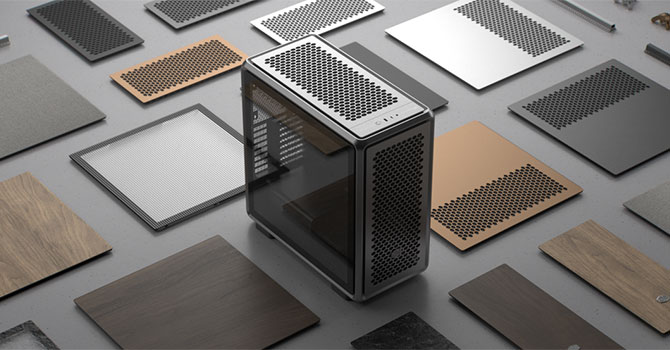
The MasterFrame is a brand-new series which—as the name implies—is based on a flexible frame design that can be seamlessly enlarged or reduced by Cooler Master in its overall size to offer bigger or smaller enclosures to complement the case family. The frame employs aluminium or steel depending on the model number, with even values denoting aluminium and uneven letting you know you are looking at the steel variant. The Master Frame in its first generation is not a fully modular case, meaning you can’t take the frame apart and add or reduce it in size to your liking. Similarly, you can’t go from a straight glass side panel to a curved one by eliminating a part of the framing and swapping out the corners. Instead, it is a framework which Cooler Master can use to dream up different variations while retaining consistent design and functionality. That said, as the image above shows, the exterior panels can easily be exchanged for different materials, or different purposes. These exterior pieces are only restricted by their required size, so things could get quite creative.
Packaging And a Closer Look


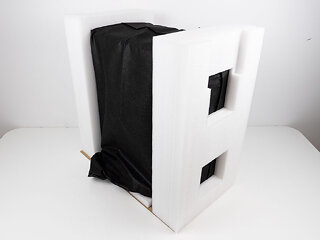
We received a pre-release variant that is close to what you could expect to see in retail, but Cooler Master has yet to finalize details and some tooling and will be showing off the chassis at CES 2025 to garner even more feedback. As such, it is literally labeled “Golden Sample” on our plain, empty packaging as well. As with most higher-end Cooler Master cases, the MasterFrame 600 uses a black cloth bag instead of a clear plastic one to protect it from scratches and fingerprints.
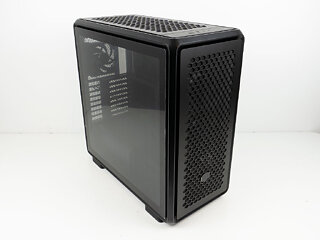
Out of the box, the chassis is not as heavy as you would expect it to be. This is certainly due to the aluminium, the steel variants will have more heft. Also, while Cooler Masters initial marketing materials and videos focus on the silver version we were sent the black one, so feast your eyes on it above.
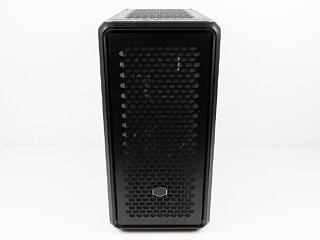
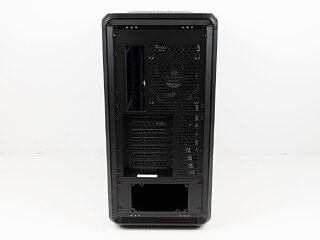
The case has a lot of symmetry, which makes sense as it also means that there are not too many different lengths and sizes for the frame elements to manufacture and deal with. The case’s depth and height is identical for example. Cooler Master has managed to infuse a bit of design branding by shaping the vents on the default front panel of our version to mimic that of their logo. As mentioned before, the case could ship with all kinds of panels, so it is not yet confirmed what the base configurations would be like and what other options there will be. Nor are there any specifics yet on how Cooler Master may sell other panels for you to freshen up the look of your case after your initial purchase. From a layout perspective the MasterFrame 600 has the usual layout as you can see when viewing it from the rear. This side of the chassis is made of three parts that are firmly riveted in place, consisting of the PSU, the expansion slot and cooling. By modularizing this, Cooler Master can reuse say the top and bottom portions, but offer a central piece that is smaller and can accommodate ITX or M-ATX boards specifically. Or, for their larger cases include a second PSU bay – all without having to redesign or retool whole parts of the enclosure.

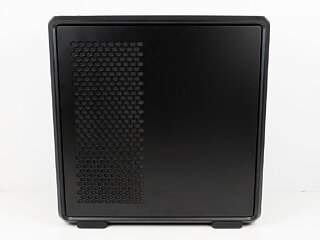
Both side panels are held in place by magnetic force. Out of the box there is a glass panel as well as metal one with side venting. Again, due to the way these are attached, all Cooler Master would have to do is stick to the constraints and mounting functionality, but could otherwise offer anything from different materials designs.
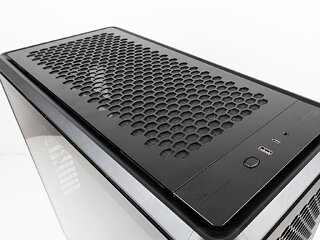
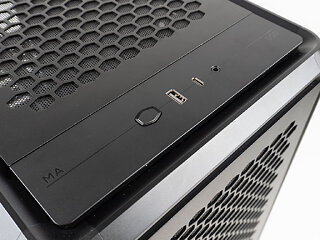
In the top, the same trend continues, with the uniquely shaped vent to allow for that all important airflow for hot air to escape the chassis. This panel is split into two parts, with the vented one as well as a solid I/O piece that may also be removed. The one our golden sample came equipped with sports just a single USB-A port, which is odd, as there is plenty of space and reason to include that second one. Even with this component, Cooler Master could offer different variations for different purposes. For example, there could be one with a temperature display, or a built-in ARGB controller, while another could sport physical, multichannel fan controls.
The Interior
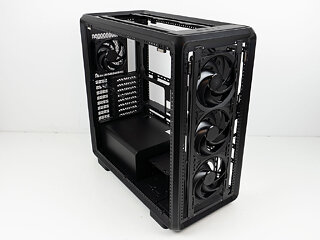
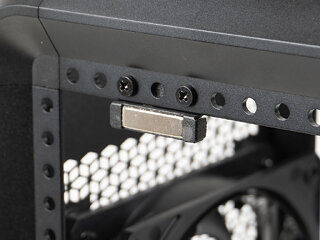
To gain access to the interior, you may simply pull the sides, front and top off the chassis. Each panel uses large magnets to keep things in place. On top of that the side panels clip onto two specifically placed screws for easy alignment. While removal of these panels is very easy and functional, modern cases in general already allow for the removal of exactly these panels. Where the MasterFrame 600 is different is the sheer accessibility once they are removed.
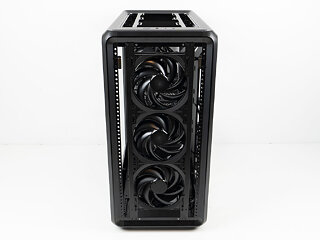
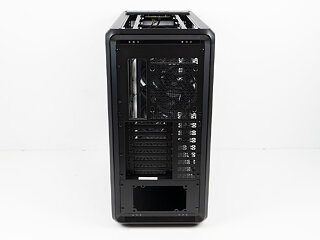
Our preview unit came with three all black, 140 mm intake units. These are mounted on a pair of removable rails, which are secured with screws at specifically drilled positions at the top and bottom, so you can accommodate 120 mm units as well. The side pieces of the frame have a row of mounting holes, while the top and bottom do not, that could be a distinct area of improvement, in combination with a redesign of the rails to be secured to those instead. That way, a user could really use this area as their canvas with the right components. Even with all the panels removed, as mentioned before, there is nothing you can remove in the rear as all pieces are riveted in place. Future generations of the MasterFrame idea may be a bit more flexible to allow the end user to change things up.
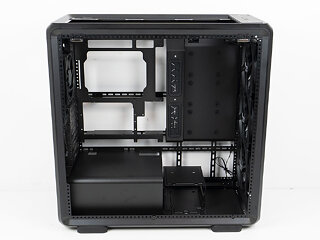
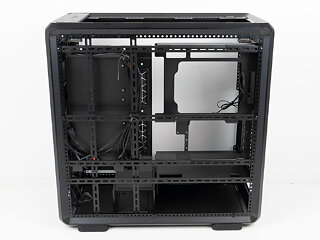
Looking inside the case it quickly becomes apparent that the MasterFrame concept is really meant to give you a basis to work in, with rails to provide a way to attach things like storage bays, cable routing & management, motherboard tray, fans and shroud to. All those components are removable and for some, like the HDD cage, there is room for you to add another one. It will be interesting to see what kind of accessories Cooler Master will offer within the MasterFrame ecosystem. Naturally the more choices a user has to customize things, the better.
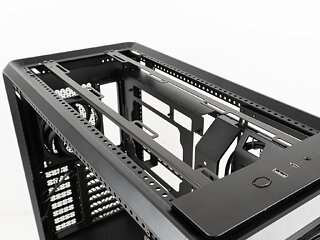
In the top, you will find another set of the exact same rails as in the front of the case, with the exact same mounting design. This again, means that there are plenty of identical frame components to use as a base for these cases.
Finished Looks
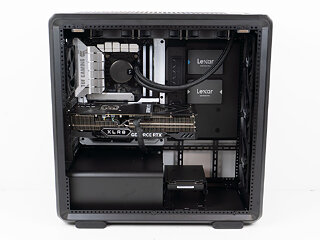
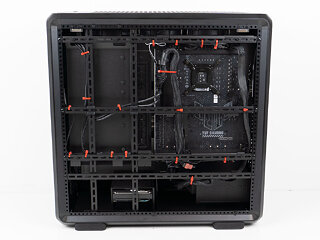
Installing components within the Cooler Master MasterFrame 600 is really no different from any other case as all parts are secured in the expected ways, with Cooler Master employing some of their specific implementations like the tool-free SSD mounting. This has been a staple for them for a while now, so it makes sense that MasterFrame utilizes it as well. What is very different however, is the cable management. There is a grid of rails on the backside, which have been placed at specific locations to allow all those mounting components to be secured in place. This means you could remove the SSD mounting plate or grommet cover and then move the vertical rails to accommodate intake fans or another radiator. On top of that, these rails act as excellent cable management system, allowing you to zip tie your wiring unto them, using that grid to get your wires to the right place without any mess to deal with. We used 18 zip ties but could have gone for even more if we felt like it, and we were able to freely choose routes for the wires that we felt were functional.
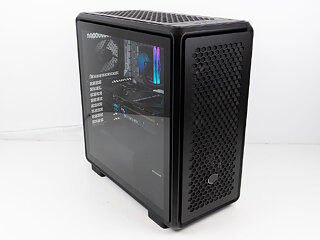
With everything installed, the Cooler Master MasterFrame 600 is clearly meant to be an oversized mid-tower to give you the room for two or even three 420 mm radiators along with the usual higher-end components that take up plenty of room. In our shipped configuration, there is room for two 3.5″ drives as well as the ability to install up to four 2.5″ units – three on the dedicated SSD plate and one on top of the HDD cage. Putting the exterior panels back into place is a breeze as they just snap back unto the frame once easily aligned.
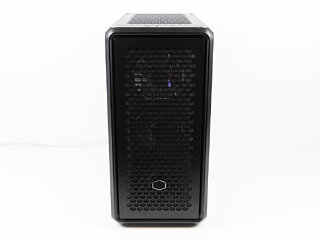
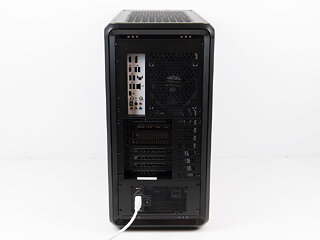
In the front, our MasterFrame uses the three included PWM fans to pull air into the chassis and one fan in the back pushing air out. Otherwise, everything is how you would expect it. There is no HDD activity or power LED, and the chassis also lacks a reset button. That is something that Cooler Master could include as part of the IO at the top, right out of the box.
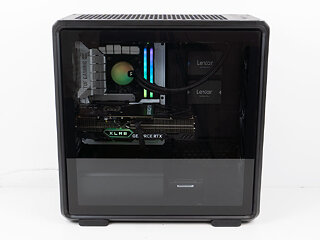
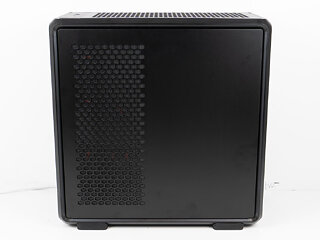
Looking at the main side of the chassis, you can see all your components, except the PSU as that is hidden underneath the solid shroud. All hard drives are visible, which doesn’t seem like the cleanest path – especially for the 3.5″ drive bays. On the other side, you can’t see much, but if you had ARGB fans on the side, they will surely shine through the metal mesh lined exhaust area.
Conclusion
It is not the first time that the industry is trying to find a way to modularize a case. In all these years, nothing has really managed to stick the landing. On top of that, with modern cases having a general sense of base modularity from the removable panels, rotatable expansion slots or detachable trays, to utilize the word modular to stand out, that product really needs to push the envelope pretty much across the finish line.
The Cooler Master MasterFrame concept doesn’t strictly mean modular for the end user from a structure perspective. You have to pick a case size and exterior shape which you will have to stick with. The frame does allow you to get creative on the exterior panels, so you can pick design, venting, materials.
In general the overall layout with the permanently attached PSU bay and motherboard area, you should still expect that core setup to play with. Where the modularity of the MasterFrame comes into play internally is with the rail system, that allows for some flexibility between cooling or storage and I/O setup. The fact that it results in some uniquely new ways to cable manage that actually works really well, is also quite the interesting aspect which should come in very handy for more compact cases that Cooler Master may have planned in the series.
The MasterFrame series feels like it stems from the idea of having modularity, with the ability to resize your chassis, buy a slew of different components and make it your own. The first iteration of this implementation clearly shows some signs of what could be possible even if it is still a ways away from achieving it. The way Cooler Master markets it also makes it feel that they really have more planned with this concept to get closer to that true modularity. As with any such implementation, the biggest long-term challenge of a modular system isn’t offering it once you have worked out the details, but actually providing a diverse and useful ecosystem of small parts and accessories to really take advantage of. With the MasterFrame series, Cooler Master managed to design something that is quite an intriguing first step, so it will be interesting to see where they go from here.
